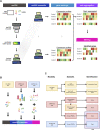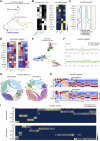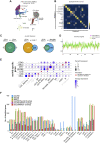resVAE ensemble: Unsupervised identification of gene sets in multi-modal single-cell sequencing data using deep ensembles
- PMID: 36875765
- PMCID: PMC9975353
- DOI: 10.3389/fcell.2023.1091047
resVAE ensemble: Unsupervised identification of gene sets in multi-modal single-cell sequencing data using deep ensembles
Abstract
Feature identification and manual inspection is currently still an integral part of biological data analysis in single-cell sequencing. Features such as expressed genes and open chromatin status are selectively studied in specific contexts, cell states or experimental conditions. While conventional analysis methods construct a relatively static view on gene candidates, artificial neural networks have been used to model their interactions after hierarchical gene regulatory networks. However, it is challenging to identify consistent features in this modeling process due to the inherently stochastic nature of these methods. Therefore, we propose using ensembles of autoencoders and subsequent rank aggregation to extract consensus features in a less biased manner. Here, we performed sequencing data analyses of different modalities either independently or simultaneously as well as with other analysis tools. Our resVAE ensemble method can successfully complement and find additional unbiased biological insights with minimal data processing or feature selection steps while giving a measurement of confidence, especially for models using stochastic or approximation algorithms. In addition, our method can also work with overlapping clustering identity assignment suitable for transitionary cell types or cell fates in comparison to most conventional tools.
Keywords: bioinformatics; deep learning; ensemble; gene set analysis; rank aggregation; single-cell sequencing.
Copyright © 2023 Ten, Yuan, Jabareen, Phua, Eils, Lukassen and Conrad.
Conflict of interest statement
The authors declare that the research was conducted in the absence of any commercial or financial relationships that could be construed as a potential conflict of interest.
Figures




Similar articles
-
Network inference with ensembles of bi-clustering trees.BMC Bioinformatics. 2019 Oct 28;20(1):525. doi: 10.1186/s12859-019-3104-y. BMC Bioinformatics. 2019. PMID: 31660848 Free PMC article.
-
Autoencoder-based cluster ensembles for single-cell RNA-seq data analysis.BMC Bioinformatics. 2019 Dec 24;20(Suppl 19):660. doi: 10.1186/s12859-019-3179-5. BMC Bioinformatics. 2019. PMID: 31870278 Free PMC article.
-
Multi-scale supervised clustering-based feature selection for tumor classification and identification of biomarkers and targets on genomic data.BMC Genomics. 2020 Sep 22;21(1):650. doi: 10.1186/s12864-020-07038-3. BMC Genomics. 2020. PMID: 32962626 Free PMC article.
-
Ensemble learning models that predict surface protein abundance from single-cell multimodal omics data.Methods. 2021 May;189:65-73. doi: 10.1016/j.ymeth.2020.10.001. Epub 2020 Oct 9. Methods. 2021. PMID: 33039573 Review.
-
Reviewing ensemble classification methods in breast cancer.Comput Methods Programs Biomed. 2019 Aug;177:89-112. doi: 10.1016/j.cmpb.2019.05.019. Epub 2019 May 20. Comput Methods Programs Biomed. 2019. PMID: 31319964 Review.
References
-
- Datta L. (2020). A survey on activation functions and their relation with xavier and he normal initialization. arXiv preprint arXiv:2004.06632 .
LinkOut - more resources
Full Text Sources

